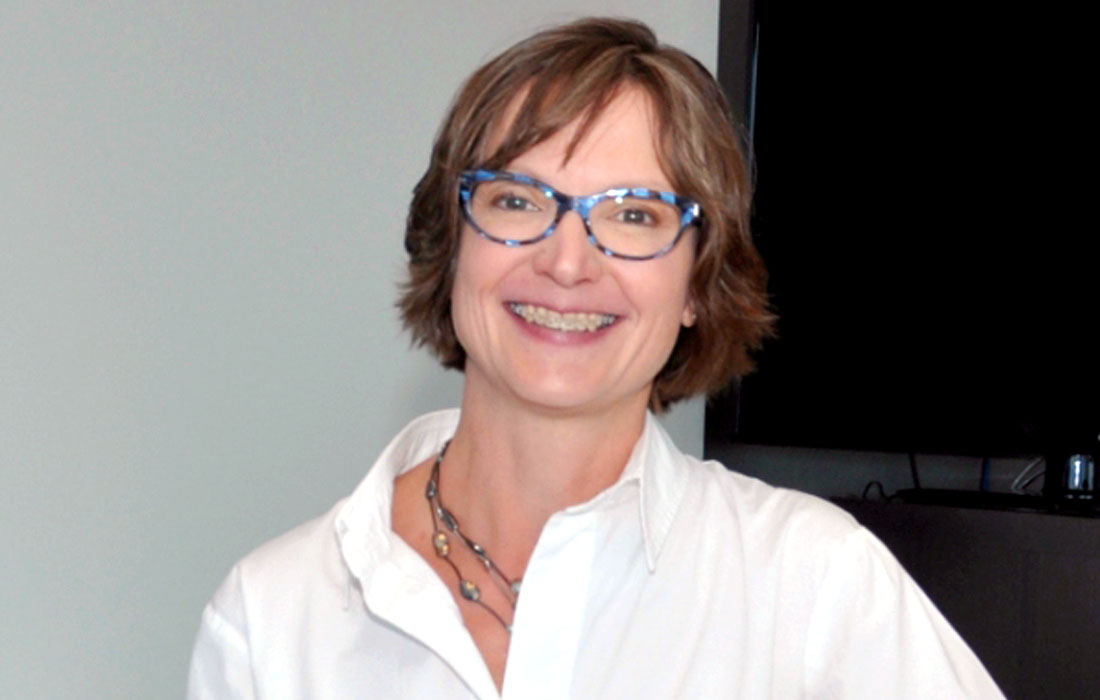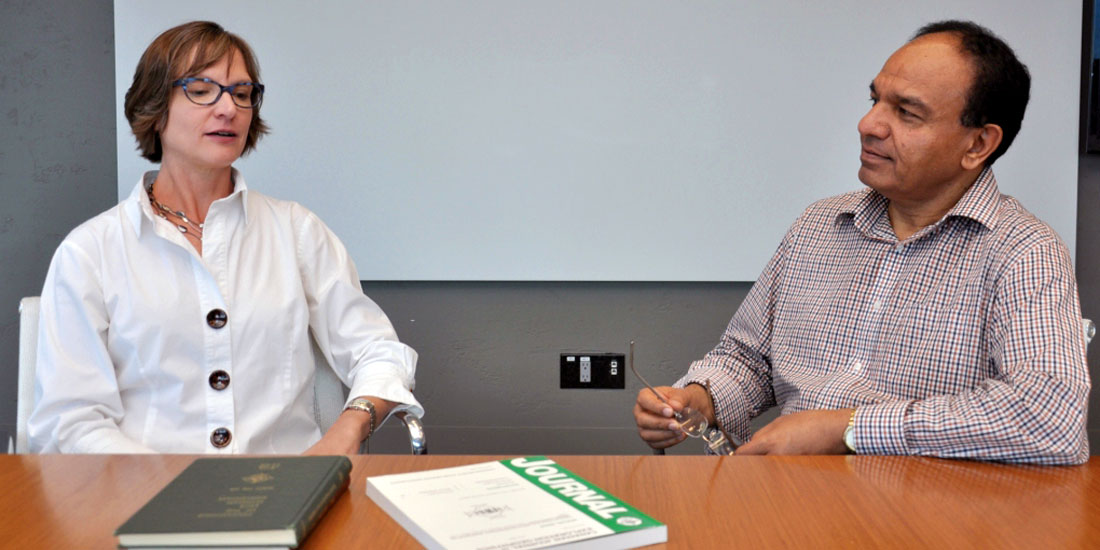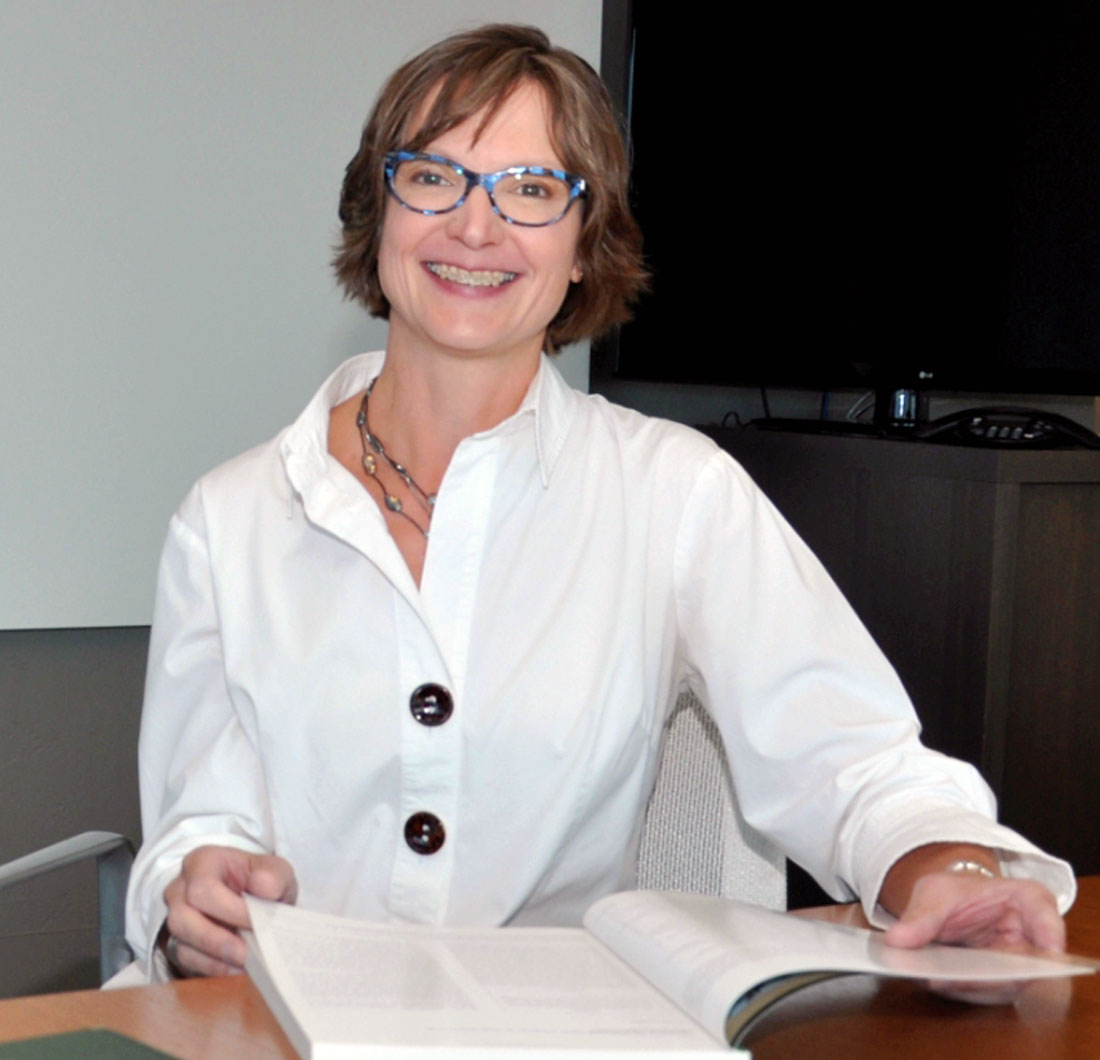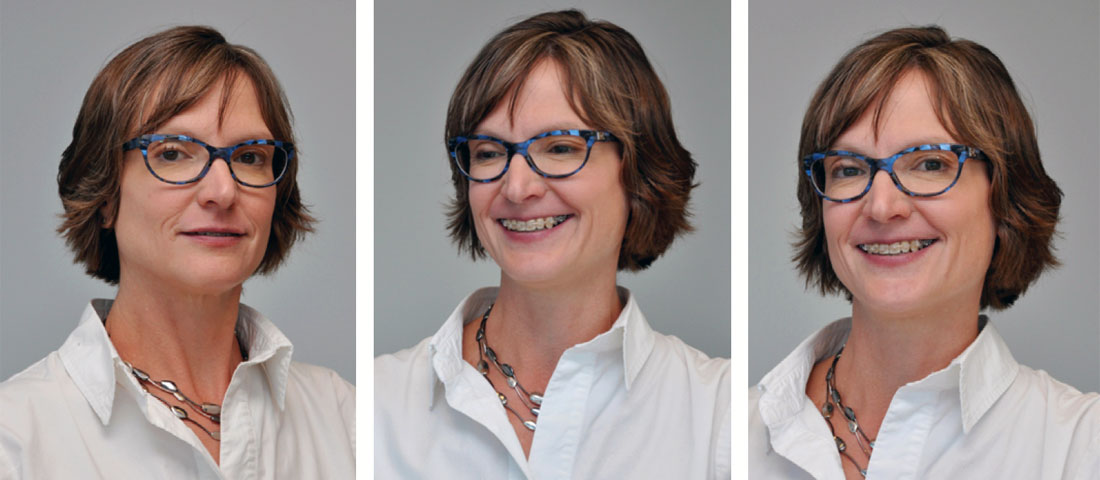
Amy Fox has been involved in geomechanical consulting in the oil and gas industry for more than 15 years. She has worked for GeoMechanics International (GMI) in California and Houston, and later when it became part of Baker Hughes in Houston and Calgary. Subsequently, she was the Geomechanics Director at Canadian Discovery Ltd., Calgary. Now she is President and co-founder of Enlighten Geoscience Ltd., Calgary.
Amy has a strong interest in using geomechanics to bridge disciplines and increase knowledge of reservoir dynamics. In addition to being a technical specialist, she spent a few years in the world of corporate training and development and was an adjunct instructor at Bucknell University.
Amy graciously agreed to our request for an interview and was very responsive and encouraging in answering our questions, some of which were looking for factual and detailed answers.
Amy, let us begin by asking you about your educational qualifications and your work experience.
I have a B.Sc. in Geology from the University of New Hampshire, and an M.Sc. and Ph.D. from Stanford University. It says Geophysics on my graduate degrees, but I’m not a seismologist. The Geophysics department at Stanford includes many different areas of research, and I was in the Rock Physics and Borehole Geophysics group. Between my Masters and Doctorate I worked for a few years for GeoMechanics International (GMI), which is where my interest in geomechanics really developed. My Ph.D. research was entirely focused on geomechanics, which is sort of a mix of classical mechanics and geology. After my Ph.D. I returned to GMI, which was soon bought by Baker Hughes. I spent a few years in a corporate training and development role before getting back into operations, at which point Baker sent me to Calgary, and a year later I left Baker and went to work for Canadian Discovery for a few years.
How did you switch over from B.Sc. in geology to M.Sc./Ph.D. in geophysics?
The University of New Hampshire geology department was very small, and geophysics was just a subject within it. I took the few geophysics courses available, which mostly focused on near-surface geophysical techniques like seismic refraction, magnetic and electromagnetic surveying and gravity. I really enjoyed those classes. I also liked physics so much that I took electives beyond the requirements for my geology degree. I knew I wanted to go to a geophysics graduate program, and my geophysics professor suggested Stanford.
So, since you received your M.Sc./Ph.D., you have worked at GMI, Baker Hughes and Canadian Discovery, and now you are running your own consultancy. What do you have to say about how your career has shaped up so far?
I’m the kind of person who doesn’t map out my future. I never said “I want to be doing blah blah blah in 5 years,” so my attitude about my career is sort-of live-in-the-moment. So far I’ve had some great roles as well as some not-so-great roles, but day in and day out I’ve generally been allowed to do work I enjoy, and in that I consider myself very fortunate. I am running my own consultancy now, but it’s really only out of necessity, as it has been for so many others recently. I have had very little work, which is no surprise and admittedly a bit discouraging. As many who are in the same situation know, there are few to no jobs to apply for. It’s an odd time to answer a question like that because the realistic answer is that I basically don’t have a career right now. But, that said, I’m pretty confident that this is a temporary situation. In the meantime I’m staying involved by volunteering, which I really enjoy, and working on some projects for the future.
What personal attributes helped you reach where you are today? Self-belief, hard work, or something else?
Probably curiosity more than anything. Definitely some hard work, but that just comes naturally to me. I think it’s mainly been my desire to try things, to see what’s next, that’s led me from one place to another. I’m kind of addicted to learning and exploring. I think also it’s a bit of resilience. I read a quote this morning that really resonated with me: “I know from experience that if I keep on living a healthy, honest good life that things will bounce back” (James Altucher in a CNBC interview). That’s kind of sums up how I feel at the moment.
Can you share one or two of your most exciting successes?
One of my proudest scientific achievements was while I was working on my PhD. My advisor sent me in his place to a meeting of the Plate Boundary Observatory (PBO) group, which was running a government funded project to monitor tectonic strain in western North America using borehole strainmeters. While at the meeting I became intrigued by an interesting trend in the data that the PBO people were simply removing mathematically in order to see the detailed strain signals. I did some literal back-of-the-envelope calculations and became convinced that the signal was a poroelastic borehole response. A lot of work later, and I had proven the concept and matched my model to the data. I won a best student poster award at that year’s Seismological Society of America’s annual meeting. The rush I get from having an idea that, through hard work and exploration, is validated is why I love being a scientist.

How about a disappointment?
Well, Canadian Discovery letting go of its entire geomechanics group was definitely a career low point for me. I was so proud to have joined the company as their first geomechanics specialist and then been able to build a small group of not just smart, but also wonderful people. I think we contributed a lot to the company and our clients. The decision may have been economic in response to the industry downturn, but it definitely sent a message that geomechanics isn’t important, which I think couldn’t be further from the truth. Caprock integrity, induced seismicity, optimizing hydraulic fractures – these are just a few of the geomechanical issues that still need addressing in our industry. Unfortunately, through the layoffs at CDL and elsewhere, the industry has lost a lot of highly experienced geomechanics experts, and I think we’ll see a negative impact from that.
Let me ask you about the promise of reservoir geomechanics for shale resource plays. Do you think geophysicists are able to answer the questions that petroleum engineers expect from them?
The short answer is no. I actually don’t think we’ve successfully demonstrated our value, and I think that’s why we are disproportionately out of work. I think that in the past we were extremely valuable in, for example, exploration in conventional plays or pore pressure prediction in conventional sedimentary basins, but in shale plays we have yet to answer the pertinent questions. The engineers want to know why certain hydraulic fracture stages contribute to production and why others don’t, or why decline curves behave the way they do, and we can’t (yet) answer those or other important questions. One of the things I emphasize when I teach is that geomechanics had decades to figure out conventional plays and just a few years to figure out unconventional ones. Of course we don’t have all the answers yet. The disappointing thing is that by letting so many of us go, the industry has undoubtedly set itself back years in getting those answers. A lot of important work that has been done in research centers and graduate programs in recent years will be lost if the people involved can’t find jobs in the industry.
The subsurface rocks are in a state of stress, the rocks themselves may be fractured, they are also under the effect of high temperatures experienced with depth, and then the chemical nature of the rocks also plays a role when considering the potential of unconventional reservoirs. Given this scenario, we need to accurately understand the in situ behaviour of the rocks so that there are no surprises at the time of drilling, keeping in mind that all these factors are acting in a coupled manner. Let me ask you about each of them individually: On what factors does the stress in the subsurface depend, and what are the different ways in which the subsurface stress can be measured?
It’s going to be a challenge to answer this one without it going too long! The earth stresses at the depths to which we drill for oil and gas are mainly due to gravitational and tectonic forces. In conventional sedimentary basins, we generally assume that one of the three principal, mutually orthogonal stresses is the overburden, which is of course acting in a vertical direction. The other two stresses are therefore horizontal. In a “normal” stress state, both horizontal stresses are lower than the overburden. In a “strike-slip” stress state, one horizontal stress is higher than the overburden, and in a “reverse” stress state, both are. However, things like crustal flexure (due to, for example, glacial unloading), geologically recent overburden removal, the presence of dramatic topography, nearby faults – all of these can alter the magnitudes and directions of the in situ stresses locally. As you said, it’s important to know the stress state wherever you are drilling and producing, but that requires data, and we know how much most oil companies like to spend money on data! The best data type for determining stresses is a wellbore image log (an “FMI” in Calgary vernacular, although that term only really applies to one of many imaging tool types). The reason image logs are so important is that they give us in situ information about how the well mechanically behaves (fails either in compression or tension) in response to the stress concentration caused by drilling a hole in a pre-stressed rock. If using other data types, like seismic, to try to interpret stress, it is critical to “ground truth” the interpretation with some wellbore data.
How does a knowledge of stress magnitude help us and how accurately can we predict it?
Knowing stress magnitudes is key to understanding what processes are affecting wells and reservoirs. Stresses are needed to model such things as wellbore stability, hydraulic fracture propagation, reservoir changes during depletion (or injection), solids production, etc. What I see in practice is that in situ stresses are often ignored, assumed or calculated from some other data (well logs or seismic, for example, which is only appropriate in specific geologic environments). This leads to totally inaccurate models. Then, when the model doesn’t reflect reality, people become disillusioned by “geomechanics” that doesn’t work.
It is possible to determine stresses to a good degree of accuracy, but as with any branch of the geosciences, there are many sources of uncertainty. With a complete data set, including density and sonic logs, image logs, triaxial core tests and a good understanding of the appropriate failure criterion, I’d say one could pinpoint stress magnitudes to within a few MPa. Obviously, as you decrease the amount or quality of the data, the estimates will become more uncertain.

The measurement of stress is usually carried out at well locations, so that it can give us the state of stress of rocks at isolated locations. How accurately can we estimate stress away from the well bores or its far-field signature? How can heterogeneity be accounted for in such estimates?
That is an excellent question and one that is difficult to answer. Three-dimensional geomechanical models based on wellbore data have proliferated over the past 5 years or so, but to be honest I haven’t had much experience in using them, the main reason being that they are very costly. Data can be interpolated between wells, but effects like stress perturbations around faults need to be accounted for. I see lots of stress models based on seismic, which I think is quite promising, but I’ve been quite disappointed by the lack of inclusion of wellbore data to constrain the seismic interpretations. There needs to be more data integration to prove that technique viable. I think there’s promise in geostatistical methods as well, but in general geostatistics has had a hard time gaining much acceptance in oil and gas workflows, from what I’ve seen.
Induced seismicity has been in the news these days, the most recent news items being from the Fox Creek area in Alberta. How can we improve our predictive capability in this regard? Can microseismic data help understand it better?
There are two main things we need to understand when it comes to induced seismicity. The first is how at risk of slipping are faults in an area given the in situ stress conditions and how those conditions are changing given what we are doing (e.g., injecting fluid). This is not necessarily easy, but it is completely achievable. The second is a bit more elusive, and that is knowing what faults are present, because their orientations and sizes will be important in evaluating the risk of inducing seismicity on them and how much energy could potentially be released. We are unlikely to achieve this using seismic alone simply due to issues of scale and seismic resolution. Microseismic definitely has potential to help. I’ve seen a little bit of literature on using passive microseismic to delineate fracture networks, enough to make me want to learn more.
To understand fractures or failure conditions in rocks, we need to understand the properties of the rocks themselves. A relevant property is the strength or brittleness of the rock. How can brittleness be determined accurately?
“Brittleness” is sort of a buzzword in geophysics lately, much to my dismay and that of my fellow geomechanics people. The reason I say this is because brittleness is not a meaningful rock property. Brittleness can be calculated in a number of ways and in a number of disciplines (e.g., civil engineering). I believe the ability to calculate it using Young’s modulus and Poisson’s ratio has contributed to the appeal of the term amongst geophysicists. Young’s modulus and Poisson’s ratio are themselves calculated from rock density and sonic velocities, so it’s an easy attribute to obtain, but it doesn’t really mean anything. In rock mechanics, a brittle material does not deform before it breaks under a load, while a ductile material does. How easily the rock breaks is a function of its strength and the manner in which it breaks. Once it breaks, how it continues to fail (e.g, how a fracture propagates) relies on a great many factors. Brittleness in oil and gas geophysics is a tremendous over-simplification that has been given far too much importance in critical decisions regarding, for example, well placement and completions. I realize that I make no friends out of industry geophysicists when I say that, but I also know that I am supported by my geomechanics and rock mechanics colleagues. I think that we need to move away from the brittleness “easy button” and look more carefully at rock strength parameters, which, although harder to determine, have more meaning in the physics we are concerned about. We also need to put more importance on accurately modeling rock fracture mechanics if we truly want to understand what hydraulic fractures are doing.
Napoleon once said, "One must change one's tactics every 10 years if one wishes to maintain one's superiority." Considering the challenges we are facing in characterizing the unconventional reservoirs, what kind of change do you think we need to bring into our approach or our workflows?
I think the biggest change that needs to happen is getting out of the mindset that we can accurately model the subsurface cheaply and easily. That’s not to say we shouldn’t be looking for ways to economize – we always need to be doing that – but it’s sort of like that thing you see on people’s office door that says “good, cheap and fast – pick any two.” I’ve already mentioned a couple of areas that I think hold great promise, geostatistics and fracture mechanics. True integration of disciplines is also needed. We talk a lot about integration in our industry, but I rarely see it actually happen. We still work in silos. So in that respect I think organizational culture needs an overhaul.
Is it possible to suggest a recipe workflow for integrating different types of data and come up with a meaningful fracture model of the subsurface?
Yes, I’m convinced there is. Do I have one? Unfortunately no, as I’ve never had the opportunity to develop one. I’ve always either been siloed myself or worked with geophysicists who were too set on their own, existing workflows. I would love to see it happen, though.

I am reminded of a quote that says, "try to learn something about everything and everything about something." Do you think this is applicable more to geophysics than other disciplines?
Very interesting question. Thinking about geoscience disciplines in general, I think perhaps it is indeed more applicable to geophysics. The reason I say that is because all of the subdisciplines in geophysics are united by one thing, physics. Although we may define ourselves as seismologists, rock physicists, geomechanicists or something else, everything we do is related, so it is important to understand a little about what everyone else is doing. That’s one of the main reasons I was so pleased to be asked to be interviewed!
You have been active in a number of service and volunteer activities. Please tell us about them.
I like to stay involved in professional societies. In the past I’ve volunteered with the Houston Geological Society, AAPG, SPE and CSPG. Currently I’m managing the SPE Connect web page for the new SPE Geomechanics Technical Section. Volunteering is a great way to grow your network and be active in areas that interest you – education, for example – that may not be part of your regular day to day job. I also like to volunteer for organizations that aren’t technical but are focused on areas I feel strongly about, such as the outdoors and mental health.
What are your other interests?
I spend the majority of my leisure time either reading or getting outside. My outdoor interests include hiking, backpacking, kayaking, cycling, crosscountry skiing and snowshoeing, so it’s pretty easy to understand why I love living in Calgary.
Do you have any words of advice or inspiration for young people considering a career in Geophysics?
We are going through some truly historic times right now, and I don’t think I could advise anyone to count on a geophysics career in the oil and gas industry. That may change eventually, if this is really just another industry “cycle,” but if I were starting out in geophysics now (which perhaps I am, again), I would focus on honing my skills for other industries such as geothermal or environmental geophysics.











Share This Interview